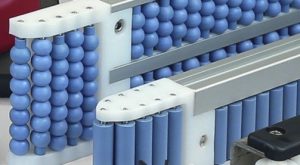 Virtually every manufacturing and distribution operation uses conveyor systems to move parts and finished products from one location to another and from one process to the next.
Virtually every manufacturing and distribution operation uses conveyor systems to move parts and finished products from one location to another and from one process to the next.
Regardless of the products being conveyed or the processes with which the conveyor system interacts, all conveyor systems have the same basic components: belts, rollers, guides, bearings, and drives, to name a few.
These are the components that provide the power and motion that enable the conveyor system to function.
However, the one conveyor system component that is easy to overlook is also one of the most critical – the conveyor transfer plate.
In this post, we'll discuss conveyor transfer modules and plates, what they are, and why they're important to your conveyor system but often overlooked.
What is the Conveyor Transfer Plate?
The conveyor transfer plate is the key part of the system that enables the things being conveyed to safely and efficiently move from one part of the conveyor system to another.
There are two types of transfer modes:
- Transfer plates
- Transfer modules
Transfer Plates
Transfer plates provide a smooth surface that allows for products to slide over the plate onto the next conveyor. Meanwhile...
Transfer Modules
Transfer Modules are constructed of an acetal frame and rollers or beads that provide a reduced friction solution for transfers.
And these two apply in two different transfer applications. Let's take a look at them.
Types of Transfer Applications
End Transfer
An end transfer takes place when one conveyor system ends and another begins or products are deposited in an accumulation area, with a conveyor transfer plate making the connection between the two.
Side Transfer
A side transfer features two conveyor systems connected perpendicularly, with one system feeding parts or finished products into the stream of the other system.
Both types of transfer take advantage of motion, gravity, and/or back pressure to move or push the conveyed products over the transfer modules and onto the next conveyor system or into an accumulation area.
So why are conveyor transfer modules and plates so important?
Why Conveyor Transfer Modules and Plates Are Important to Conveyor Systems
Because they have to efficiently and effectively handle the dynamic forces at play where two systems interact and enable products to safely and reliably make the transfer–often at different speeds and directions–without disruption.
Conveyor transfer plates, like the other components in a conveyor system, are subject to varying degrees of wear and tear, depending on the products being moved and their speed and volume.
Natural UHMW, oil-filled UHMW, or other oil-filled plastics are commonly used in producing transfer plates. These plates are often used in moving heavier, more stable items.
Transfer modules are produced from acetal with acetal beads and rollers of acetal or stainless steel rollers and are usually used for transferring smaller, lighter items.
Want to Learn More About Transfer Modules and Plates?
To learn more about conveyor transfer plates and the various models and configurations available, contact the material handling systems experts at Slideways.


